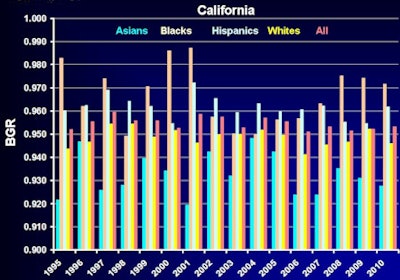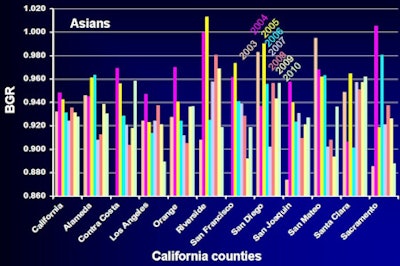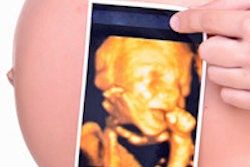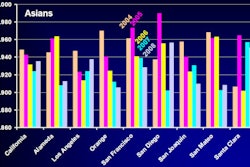
Although a definitive cause-and-effect relationship can't be proved, access to keepsake ultrasound centers continues to be linked with lower numbers of female births among some Asian groups in California, according to a talk at the American Institute of Ultrasound in Medicine (AIUM) annual meeting.
Continuing a trend identified for prior years, several California counties had abnormally low female-to-male birth ratios among Asians in 2010, a development that was associated with the proliferation of keepsake ultrasound centers that offer gender-determination services, according to G. Sharat Lin, PhD, of Advanced Imaging Associates in Fremont, CA.
On the bright side, Lin found a recent improvement in ratios in the past few years in Santa Clara County, which has the second-highest Asian subpopulation (27.3%) in California.
Keepsake ultrasound's effect?
For several years, Lin has been examining birth-gender ratios (female births per 1,000 male births) to investigate if commercial access to 4D keepsake ultrasound studies could be facilitating gender-specific abortion among Asians in California. In 2010, he presented research at the AIUM meeting that hinted at a relationship between keepsake ultrasound and birth-gender ratios in the state.
In his latest study, Lin also delved deeper into the statistics to track specific birth-gender ratios (BGRs) among Asian ethnic subpopulations in Santa Clara County. He presented his results during a scientific session on Saturday at the meeting in Phoenix.
In the additional analysis for Santa Clara County, Lin found that Asian ethnic groups in the county who were known to have a traditional gender preference for boys had clearly lower female-to-male birth ratios than those Asian ethnic groups who did not have a preference.
"Mothers born in China, India, and Vietnam [have female-to-male birth ratios] that are well below normal, and those from Pakistan are much closer to normal," Lin told AuntMinnie.com. "Breaking it down by ethnic group is showing us that this is not simply noise or some kind of a random fluctuation. These are showing up where we expect them, in the ethnic groups where there is a cultural preference for boys."
Using the California Department of Public Health's Vital Statistics Query System, Lin has obtained BGR statistics by ethnic group in the county and state. Birth statistics obtained from the Santa Clara County Department of Public Health allow for categorization by the mother's birthplace. Lin recorded BGRs for racial and ethnic categories, and he also tracked the number of commercial 4D keepsake ultrasound centers in operation over time using Web searches.
Statewide, Asians have had the lowest birth-gender ratio (considered to be less than 930 female births per 1,000 male births) among ethnic groups in California from 1995 to 2010.
 |
| Female births per 1,000 males in California by race, 1995-2010. All images courtesy of Sharat Lin, PhD. |
Looking specifically at Santa Clara County, the birth-gender ratio for the general population ranged from 940 to 962 between 1995 and 2010. However, the Asian BGR ranged from 902 to 965 during the same time period, and was less than 910 four times from1995 to 2006, according to Lin.
Further investigation into Asian subpopulations in Santa Clara County found that the South Asian birth-gender ratio ranged from 905 to 994 between 1995 and 2010, and was less than 910 six times from 1995 to 2006. The Chinese BGR ranged from 784 to 1,040 between 1995 and 2010, and was less than 910 seven times from 1995 to 2006.
In good news, there has been a positive trend from 2007 to 2010 in overall Asian birth-gender ratio in Santa Clara County. While a few more years will be needed to confirm the recovery to more normal levels among Chinese, Indians, and Vietnamese, these gains could be due to the increase in the number of second-generation immigrants becoming parents. Parents growing up in the U.S. may have less gender preferences than their parents did, Lin said.
 |
| Female births per 1,000 males for Asians by California county, 2004-2010. |
Alarming trends in other counties
Elsewhere in California, however, counties that have continuing proliferation of keepsake ultrasound centers experienced alarmingly low BGRs among Asians in 2010, Lin said.
Low birth-gender ratios among Asians in urban counties in 2010 were as follows:
- Sacramento: 888
- Los Angeles: 889
- San Francisco: 919
- Riverside: 919
- San Joaquin: 927
"While we still don't have a direct proof of cause and effect, we see a correlation that in counties like San Joaquin County and Sacramento County, [there's] a downward trend in BGRs, and at the same time, continued proliferation of these keepsake ultrasound centers," he said. "Another alarming trend is that in the metropolitan areas where there were not many keepsake ultrasound centers before, there are many new ones. It will take some time for us to see what impact that will have, particularly in more maturing immigrant populations."
Quite a few new centers have opened in the past two or three years, not only in outlying areas such as San Joaquin County and inland areas of Alameda and Contra Costa County, but even in San Francisco and San Jose, Lin said.
"Four or five have come up within the last few years in and around the Bay Area," he said.




















